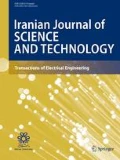Abstract
Proportional fairness in the downlink of a single-cell multi-carrier code-division-multiple-access (MC-CDMA) network in the presence of a jammer is considered in this paper. We assume the jammer can find the spreading sequences of the base station (BS) and use them in causing interference on all available channels to reduce the sum rate of the BS to users to the extent possible. Besides, we require the BS to apply proportional fairness in its transmissions to users in the presence of the jammer. Interactions between the BS and the jammer are modeled by a non-cooperative zero-sum generalized game. The game is solved via quasi-variational inequality (QVI), and optimal strategies (transmit power levels) are obtained in closed forms, which are not in the form of water-filling formula. Moreover, we propose a new gradient-based algorithm to solve the QVI, prove its convergence, and obtain the optimal strategies.











Similar content being viewed by others
References
Altman E, Avrachenkov K, Garnaev A (2007) A jamming game in wireless networks with transmission cost. Proc Lect Notes Comput Sci 4465:1–12
Altman E, Avrachenkov K, Garnaev A (2008) Generalized α-fair resource allocation in wireless networks. In: IEEE conference on decision and control, pp 2414–2419, Mexico, December, 2008
Altman E, Avrachenkov and K, Garnaev A (2009) Jamming in wireless networks: the case of several jammers. In: IEEE conference on game theory of networks, pp 585–592, May 2009
Altman E, Avrachenkov K, Garnaev A (2010) Fair resource allocation in wireless networks in the presence of a jammer. Perform Evaluat 67:338–349
Altman E, Avrachenkov K, Garnaev A (2011) Jamming in wireless networks under uncertainty. Mobile Netw Appl 16:246–254
Anand S, Sengupta S, Chandramouli R (2010) An attack-defense game theoretic analysis of multi-band wireless covert timing networks. In: IEEE international conference on information and communication, pp 1–9
Bertsekas DP, Tsitsiklis JN (2000) Gradient convergence in gradient methods with errors. Ind Appl Math 10(3):627–642
Boyd S, Vandenberghe L (2004) Convex optimization. Cambridge University Press, Cambridge
Chen Ch, Song M, Xin Ch, Backens J (2013) A game-theoretical anti-jamming scheme for cognitive radio networks. IEEE Netw 27(3):22–27
Facchinei F, Kanzow C (2007) Generalized Nash equilibrium problems. vol 5, no 3. Springer-verlag. pp 173–210
Fang Zh, Song T, Li T (2015) Energy harvesting for two-way OFDM communications under hostile jamming. IEEE Signal Process Lett 22(4):413–416
Garnaev A, Trappe W (2014) Fair resource allocation under an unknown jamming attack: a bayesian game. In: IEEE international workshop on information forensics and security (WIFS), pp 227–232
Hanawal MK, Abdel-Rahman MJ, Krunz M (2016) Joint adaptation of frequency hopping and transmission rate for anti-jamming wireless systems. IEEE Trans Mobile Comput 15(9):2247–2259
Kashyap A, Basar T, Srikant R (2004) Correlated jamming on MIMO gaussian fading channels. IEEE Trans Inf Theory 50(9):2119–2123
Meshkati F, Chiang M, Vincent Poor H, Schwartz SC (2006) A game-theoretic approach to energy-efficient power control in multicarrier CDMA systems. IEEE J Select Area Commun 24(6):1115–1129
Ng DWK, Lo E, Schober R (2012) Energy-efficient resource allocation in OFDMA systems with large numbers of base station antennas. IEEE Trans Wirel Commun 11(9):3292–3304
Oro SD, Galluccio L, Morabito G, Palazzo S, Chen L, Martignon F (2015) Defeating jamming with the power of silence: a game-theoretic analysis. IEEE Trans Wirel Commun 14(5):2337–2352
Pelechrinis K, Koufogiannakis Ch, Krishnamurthy SV (2009) Gaming the jammer: is frequency hopping effective? In: IEEE conference on modeling and optimization in mobile, ad hoc, and wireless networks, WiOPT, pp 1–10
Popper Ch, Strasser M, Capkun S (2010) Anti-jamming broadcast communication using uncoordinated spread spectrum techniques. IEEE J Sel Areas Commun 28(5):703–715
Shafiee S, Ulukus S (2009) Mutual information games in multiuser channels with correlated jamming. IEEE Trans Inf Theory 55(10):4598–4607
Wang B, Wu Y, Liu KJR, Clancy TC (2011) An anti-jamming stochastic game for cognitive radio networks. IEEE J Sel Areas Commun 29(4):877–889
Wei S, Kannan R, Chakravarthy V, Rangaswamy M (2012) CSI usage over parallel fading channels under jamming attacks: a game theory study. IEEE Trans Commun 60(4):1167–1175
Wu Y, Wang B, Liu KJR, Clancy TC (2012) Anti-jamming games in multi-channel cognitive radio networks. IEEE J Sel Areas Commun 30(1):4–15
Xiao L, Chen T, Liu J, Dai H (2015) Anti-jamming transmission stackelberg game with observation errors. IEEE Commun Lett 19(6):949–952
Xie R, Yu FR, Ji H (2012) `Dynamic resource allocation for heterogeneous services in cognitive radio networks with imperfect channel sensing. IEEE Trans Veh Technol 61(2):770–780
Yang D, Xue G, Zhang J, Richa A, Fang X (2013) Coping with a smart jammer in wireless networks: a stackelberg game approach. IEEE Trans Wirel Commun 12(8):4038–4047
Zhu Q, Li H, Han Z, Basar T (2010) A stochastic game model for jamming in multi-channel cognitive radio systems. Proc IEEE ICC 2010:1–6
Author information
Authors and Affiliations
Corresponding author
Rights and permissions
About this article
Cite this article
Noori, H., Sharafat, A.R. Proportional Fairness in MC-CDMA Networks in the Presence of Jammers: A Game Theoretic Approach. Iran J Sci Technol Trans Electr Eng 41, 267–282 (2017). https://doi.org/10.1007/s40998-017-0039-z
Received:
Accepted:
Published:
Issue Date:
DOI: https://doi.org/10.1007/s40998-017-0039-z




